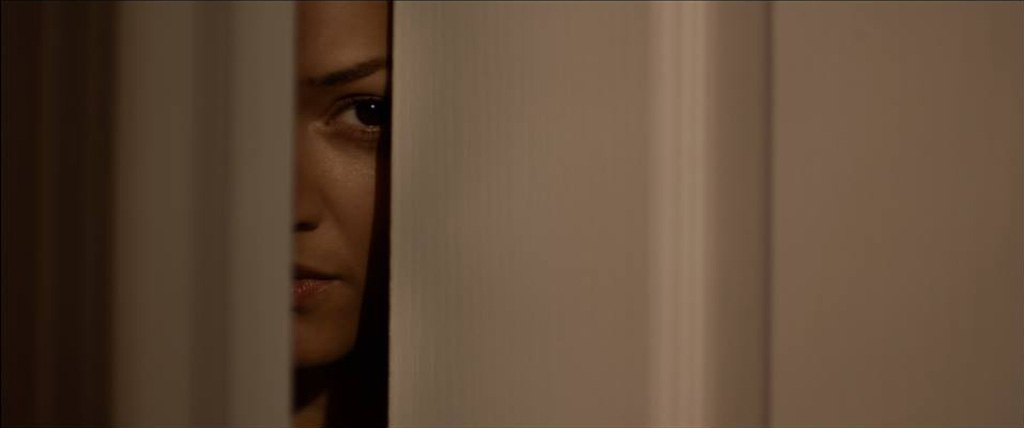In Michael Walker’s films, people have a habit of going missing, or at least it may feel that way even if they’re still in the room. With his first film “Chasing Sleep,” it’s the wife of a college professor (Jeff Daniels) whose disappearance causes her husband to slowly grow mad while Walker’s second, the comedy “Price Check” sees a mid-level supermarket employee have his identity subsumed by his boss, a delightfully manic Parker Posey. So it is no surprise to see his latest film “The Maid’s Room,” which debuted recently in back-to-back premieres at the Hamptons and Austin Film Festivals, told from the perspective of someone whose job it is to recede into the background, with Walker saving his curveballs for the plot of this Hitchcock-esque mystery.
A thriller where the messiness of contemporary life encroaches on the old wealth enclave of the Hamptons, “The Maid’s Room” is nearly as classic in its style as the house where the Crawfords reside, a family that only occasionally comes in on weekends but requires the services of a live-in maid (Paula Garces). At first, the $400 a week with room and board is more than enough for Drina, the Colombian housekeeper who tells the missus (Annabella Sciorra), “I like being alone” and learns soon enough her most daunting task is keeps ants out of the house. Yet when the Crawfords’ college-aged son Brandon (Philip Ettinger) comes home to relax and host friends while his parents are away, Drina begins to learn that her cleaning duties aren’t exactly what she signed up for as her silence becomes less of a personal preference than a troubling job requirement.
The tension is heightened by Drina’s uncertain status as an illegal immigrant and the erosion of power of the family’s patriarch (Bill Camp) who learns that his money and influence isn’t worth as much as it used to. But in relying on sleek, old school sophistication, Walker does just fine, inspiring nervous titters as the characters onscreen discover the limits of their conscience with some finding they have none. While in town for the Austin Film Festival, Walker spoke about how the story evolved from an idea for a short film, why the wait was worth it to get the house he wanted to film in and why he finds more space to be creative without the use of a handheld camera.
I wrote the script probably 20 years ago that started as a short, then about 10 years ago, I turned it into more of a traditional ghost story [as a feature]. It did pretty well. I just kept getting options and then it would fall apart. Finally, Dolly Hall and I produced another film [“Price Check”] last year and she made this come together. When it was a short film, it was mostly about the relationship between the maid and the son and I was always interested in that class difference, but over the years, it became much more complicated.
It’s not just about the class differences, it’s also about this fight between truth and power and how people in power try to manipulate the truth, but in the end it’s the truth is what happens. That was what interested me and the ghost story eventually worked its way out.
Well, this house does seem haunted, though not by the paranormal.
It was more of a traditional ghost story in the sense there was more ghosts in it. Eventually, it started to seem that ghosts are unseen. When you’re working with the guilt of people, you can have ghosts in a different kind of way. It does feel a bit like a ghost story [now]. It’s a ghost story in reverse because generally a ghost story starts with the haunted, then you find out why there’s ghosts around. Usually, it’s because there was some crime committed or some wrong that was done, then whoever the protagonist is rights that wrong the ghost goes to heaven or wherever they go to close the story. Here, you see the events leading up to the crime.
While writing, did you have the specific house you shot in in mind?
The house was so fortunate because it’s actually nearby where I live. I had been in the house before because I knew the people who lived there. They were friends and I would go there for birthday parties with my kids, my kids and their kids were friends. It was always the perfect house to shoot in, but when I asked them, they said no. Then when we it was time to actually shoot the movie, it turned out that they sold the house and the new owners said that we could shoot there, so it’s incredible. We could have never have done [this] without that. We did look at some other houses but that house was really perfect Amy Williams, the production designer, also helped there. She definitely made it complete, but it’s a strange house to begin with.
You have a beautiful shot of Drina the maid walking that spans the length of the house to where it meets the water out back. It looked like it must’ve been incredibly difficult, but was it?
That shot is funny because it’s basically a crane shot. Everybody talks about technological advances in digital cameras, but actually, there’s been a lot of technical advances in the film equipment itself. That was actually a long graphite jib arm, which didn’t exist a few years ago as far as I know, and it enables you to get that beautiful shot without the expense of getting a crane in there, which we could we never afford.
It was important for the film because we were trying to contrast the beauty of the Hamptons with the situation that Drina was in and the ugliness of what was going on. Also, I always thought there was a battle between the nature outside and the inside of the house [where] there is virtually no nature except for the ants that can get in there anyway, across that barrier.
It’s funny you mention new technology because this film feels old fashioned in the best way and I read in another interview you gave how you’re not a fan of handheld camera, which is a hallmark of the digital era. Did you feel like what you were doing was a situation where what’s old is new again?
I just don’t like handheld cameras, [which] has its place, but everything is shot handheld these days. It’s definitely fun to work with the camera in the way [we did on this film]. On this budget level, it is very hard to get what you want because you’re always trying to get more shots to do. You end up not quite getting the shots you want, but it’s fun because you create new ones too. A few more days would have helped a little bit, but I think it still looks pretty great. [Cinematographer] Scott Miller did an amazing job with the look.
The films that are handheld are handheld for two reasons. One because it’s the trend and it gives an edgy, active look even if nothing is happening. But also it’s a budgetary thing because if you shoot scenes handheld, you get a lot of coverage very quickly in a way that you can’t do in the traditional sense. So I would love to think there is going to be a new trend that’s getting rid of the handheld because I’m tired of it and I think it lacks a lot of imagination. Because of budgetary restraints, the trend might not naturally not change.

It was. There was a time when this came together with a slightly bigger budget and we’re trying to get some other names. Not huge names, but people up-and-coming and some actresses didn’t want to play a maid. After this, Paula [Garces] actually after this went on to become a maid who gets killed in a TV show, so she’s okay with it, I think. [laughs] There’s a stereotype with Latin actresses and I think they get offered a lot of maids, but Paula, to her credit, identified with this character in way that was really magic to watch. When she came in to the audition, it was incredible. She said her grandmother was a maid when she was an immigrant from Colombia and she related to a lot of the experiences of the character. She really does a great job in the film.
Was it tricky to avoid the clichés of that particular character while writing it?
She’s a maid, but she could really be any person. All she has to do is clean, so what was fun with her was to make her a real person. Her character became more complex as it went along, but basically it was to give her as much of humanity as we could because the family is trying to dehumanize her. She’s curious, she is ambitious and she’s… I don’t even know how realistic a character she is in a lot of ways because I haven’t seen that many maids that look as gorgeous as Paula. At the same time, the style of the film helps that and there’s certain parts of her character that you see and it is mostly not in the dialogue. She’ll watch the family and how she gave her opinions of these things without her saying anything, it’s subtle. What’s great about Paula’s performance is she’s looking at all this wealth and the world around her not in a judgmental or a jealous way, but in a respectful way or a way that she can see what the American dream might be.
This actually premiered first at the Hamptons Film Festival. What was it like to see this with a hometown crowd?
The Hamptons was fun because it was the Hamptons and it takes place in the Hamptons. Especially in the early parts of the film, they seemed to get the jokes there a little more than other places. It’s great because I know people have mixed reactions at the end of the film, but I could tell during the film they are thoroughly engaged and they react to the suspense, which is really important. In the end, it’s a tragedy, but I tried very hard to make it a tragedy that wasn’t depressing. Some people don’t like that, but people who do like it, I think like it a lot.
“The Maid’s Room” will be released on August 8th.





